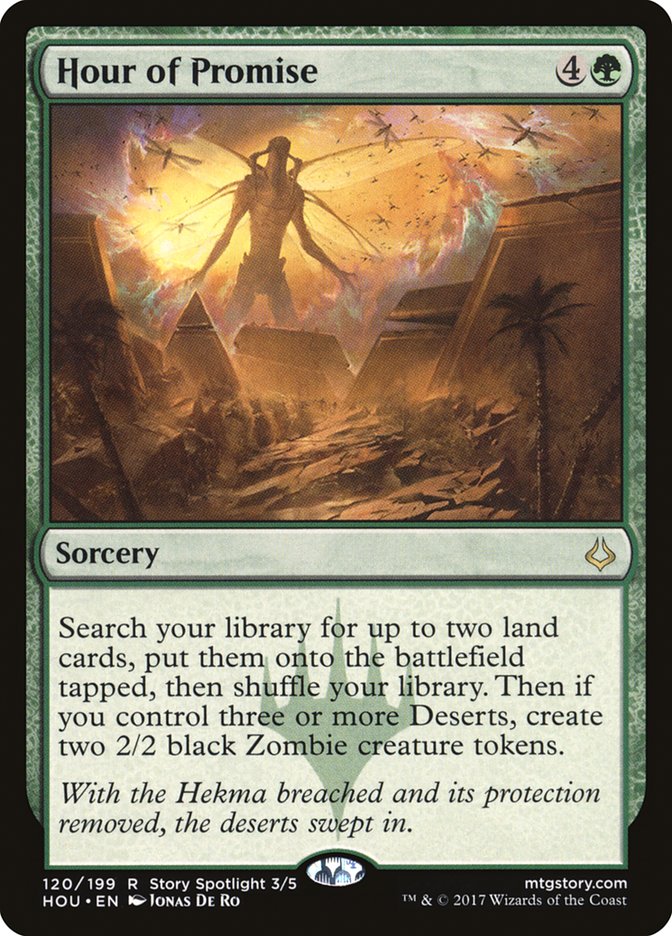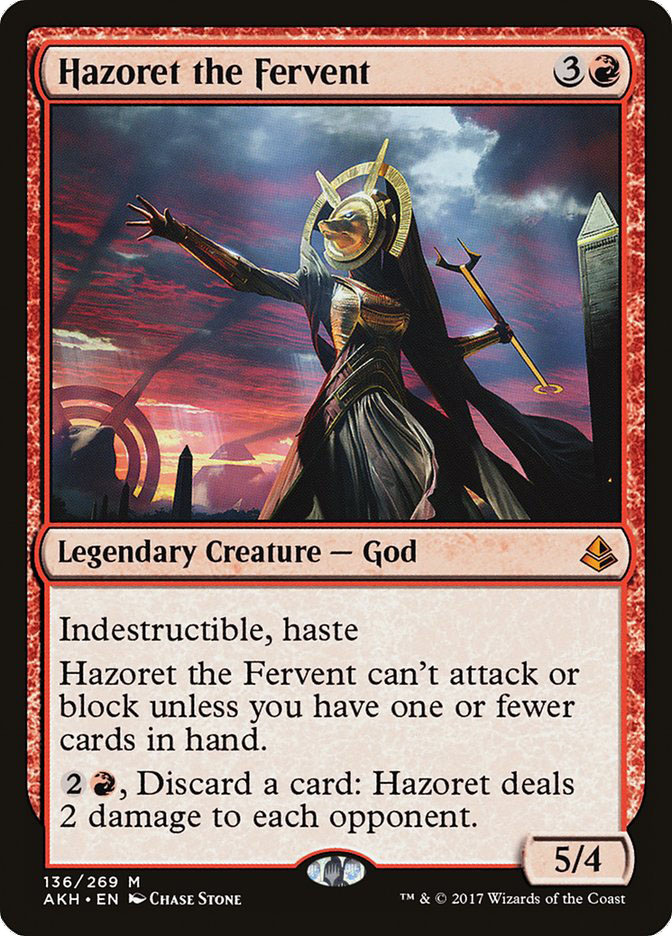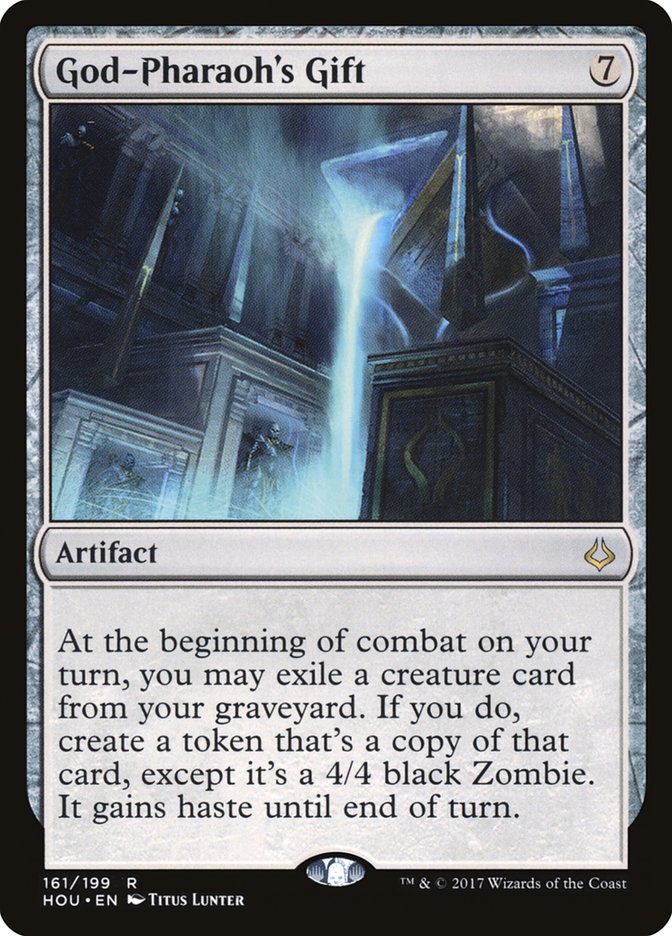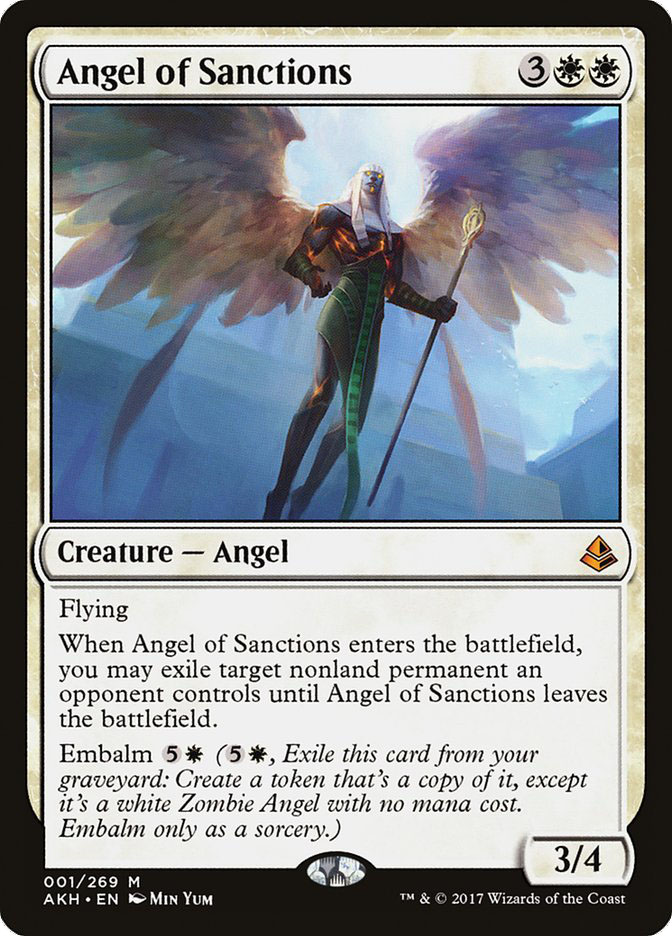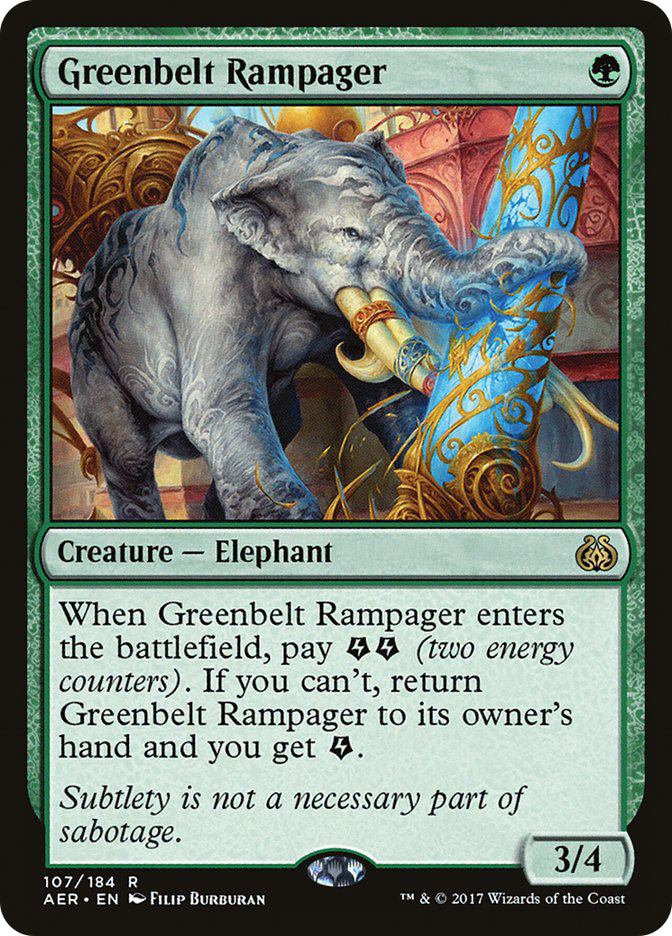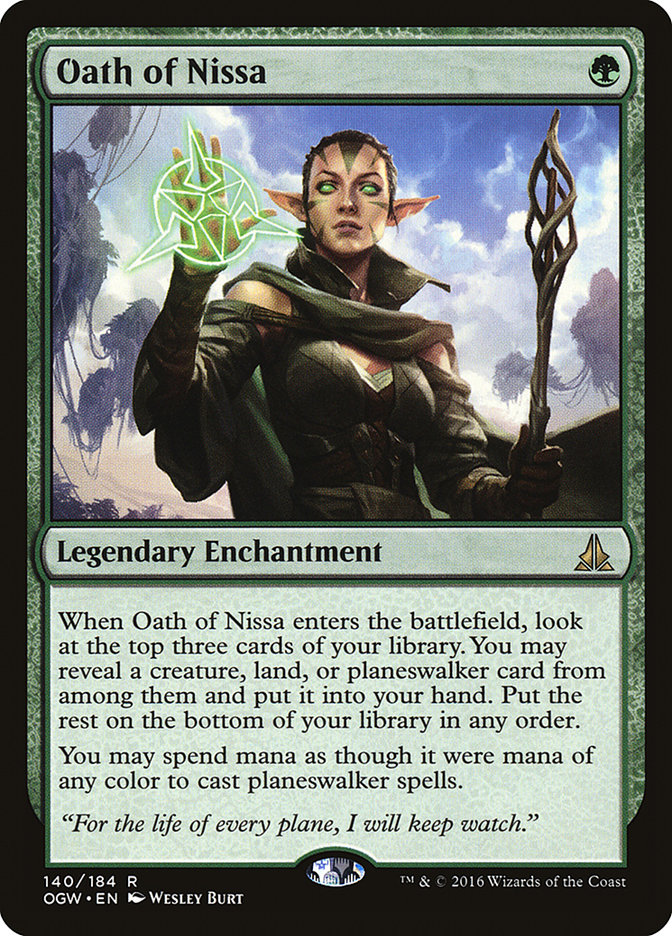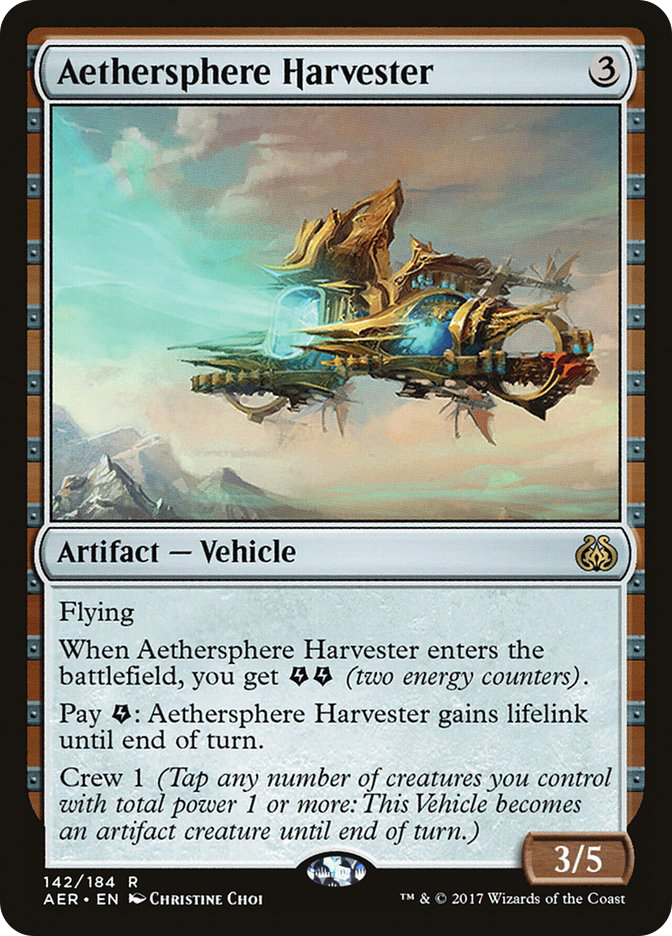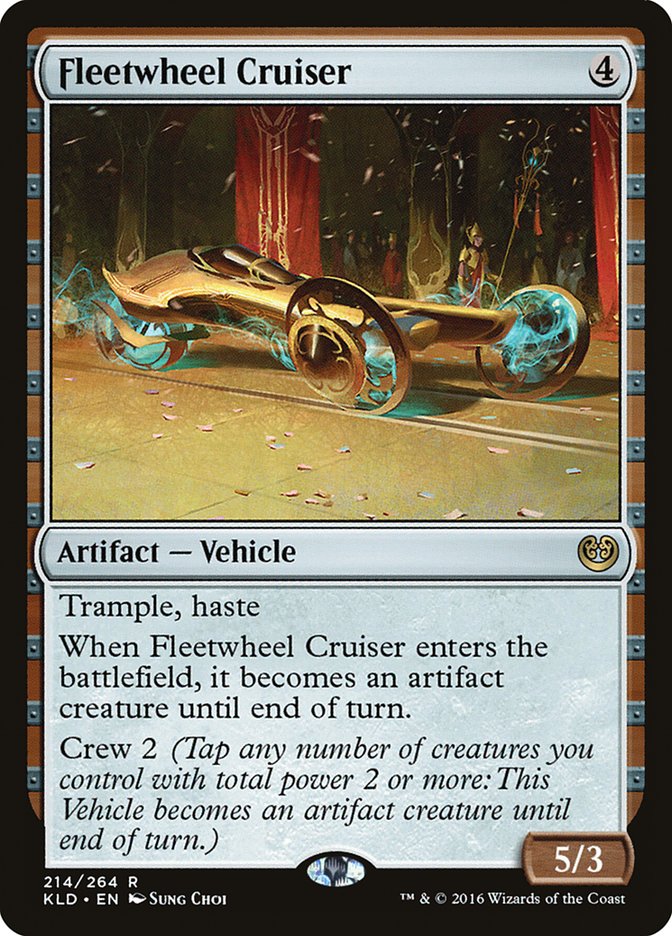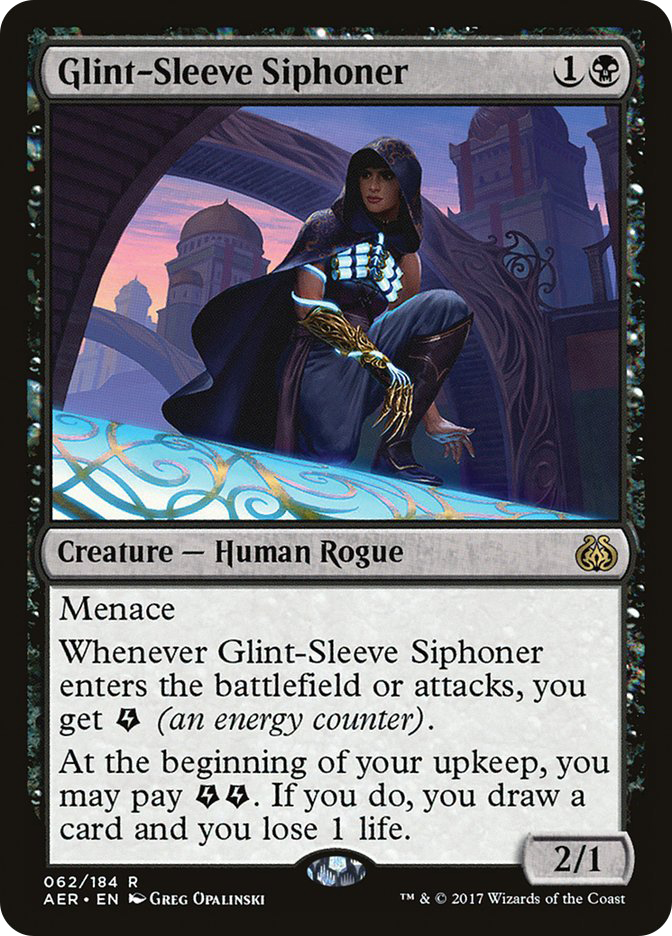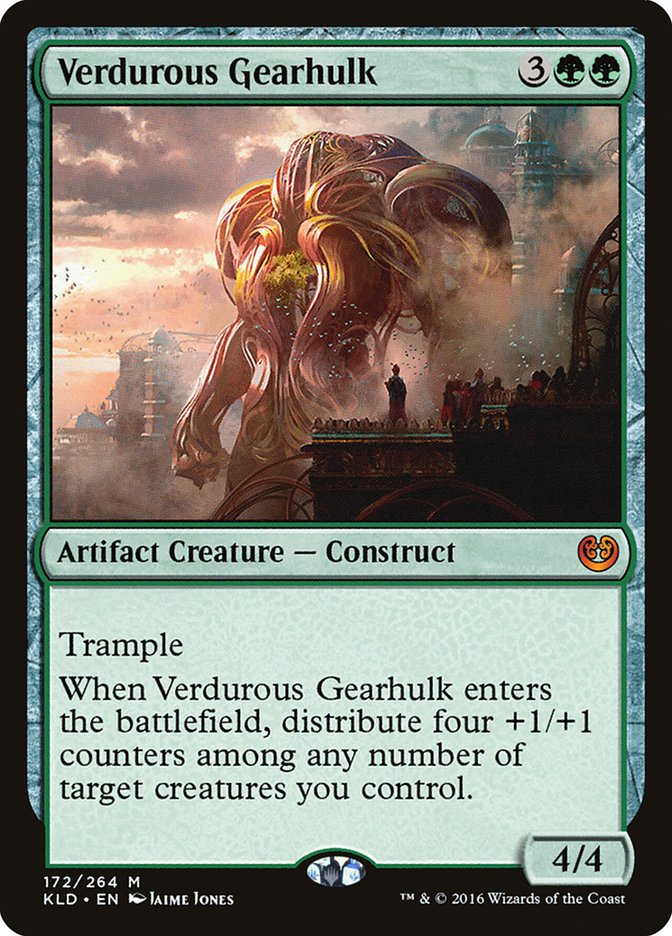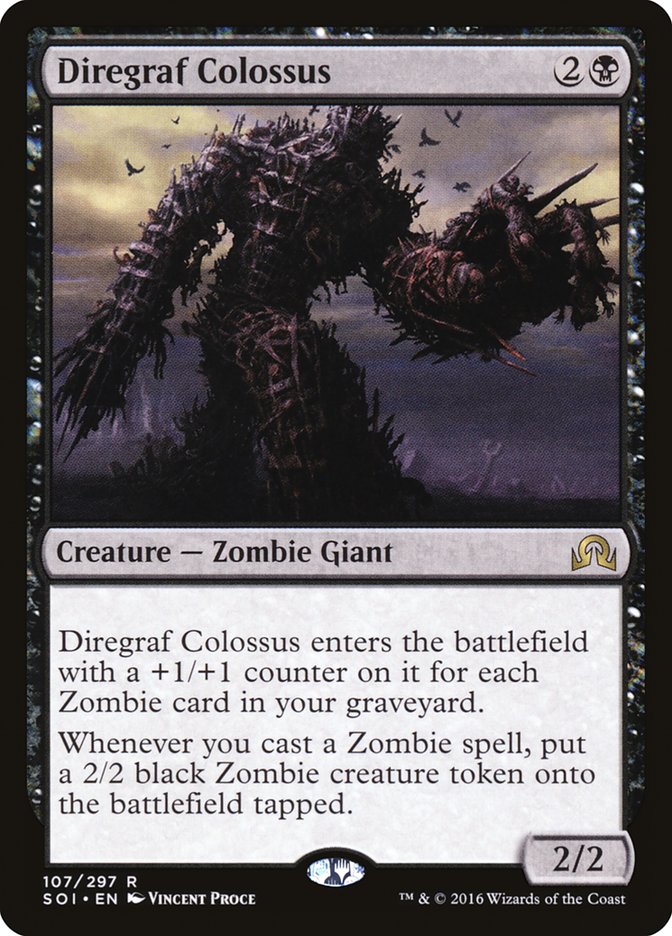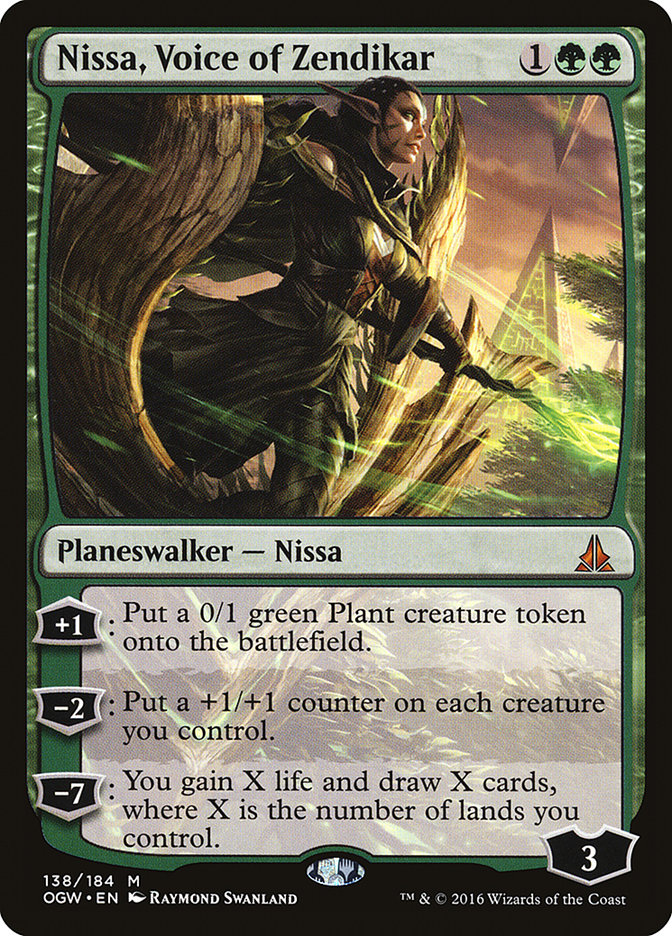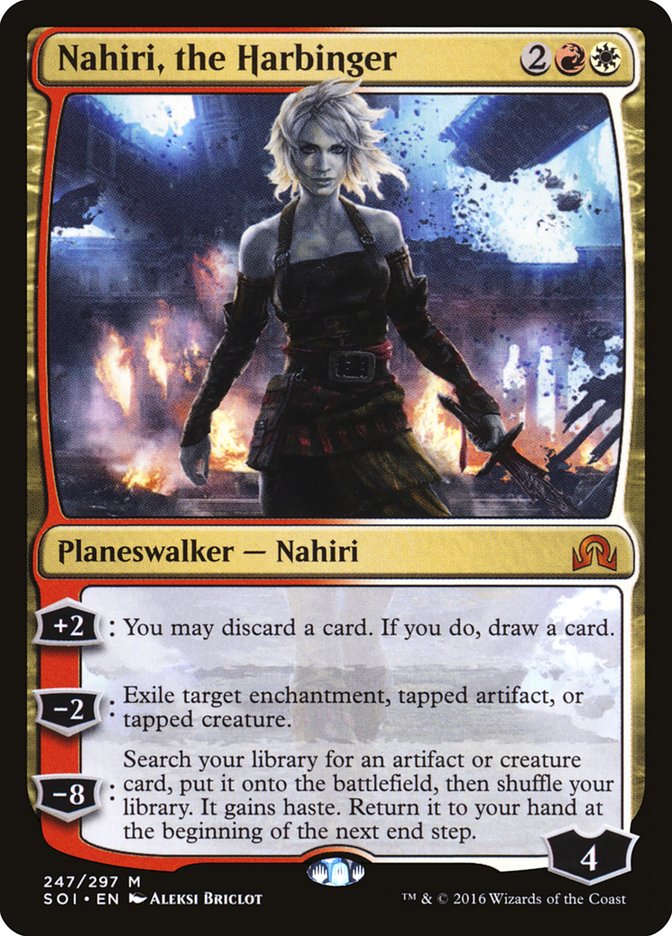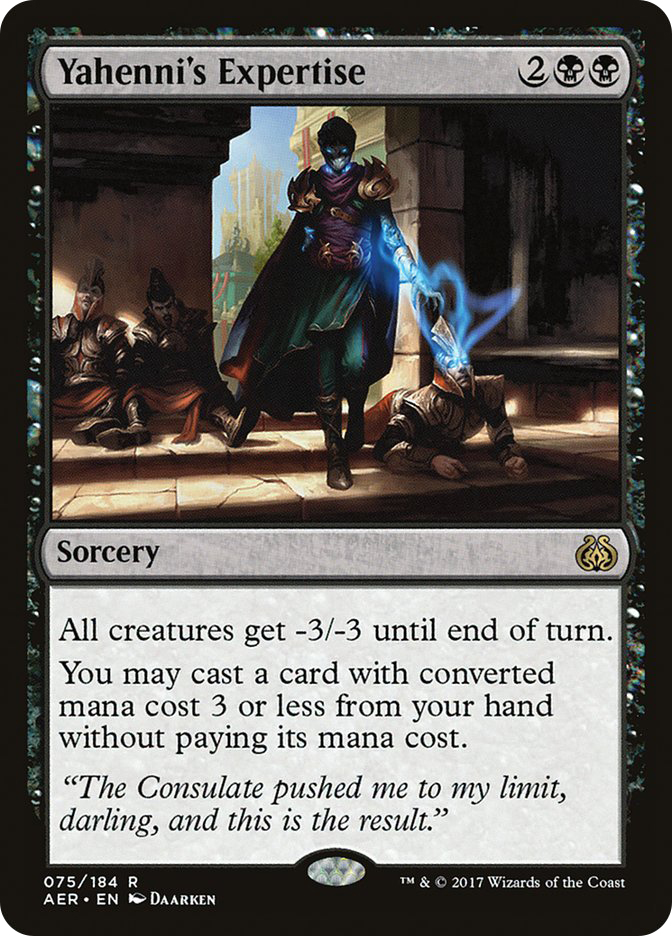From the start, it was pretty clear that Hour of Devastation Standard was not going to be about breaking new ground. It was a small set, the format was fairly explored post-Aetherworks Marvel ban, and the mechanics weren’t inherently broken like emerge. That meant the following surviving decks needed to be covered: Zombies, W/U Monument, Mardu Vehicles, Temur Energy, U/R Control, and B/G Energy.
Official brew time ended with the first round of new results from Magic Online and other PTQs. Mono-Red became a relevant contender, and later God-Pharaoh’s Gift poked its head in. Our successful brews in early testing were Hour of Promise ramp decks and Thought-Knot Seer decks with the new pain-colorless Deserts, leading to the following testing metagame:
Zombies
W/U Monument
Mardu Vehicles
Temur Energy
U/R Control
B/G Energy
Mono-Red Aggro
G/R Ramp
Colorless Eldrazi Decks
From there we created a grid and battled.
Our first big discovery was that U/R Control didn’t actually beat anything. At best it was good Game 1 and okay but not great post-sideboard.
I’ll be missin’ you.
W/U Monument was next out. Abrade was just too brutal, and some matchups like B/G Energy actually turned out horribly if your opponent just played around Dusk // Dawn. Leaving Winding Constrictor as a 2/3 and spending all of your mana on Walking Ballista was just unbeatable.
Temur Energy died to Mono-Red and Zombies and Dusk // Dawn. I was off it pretty early, though some team members played the deck. The cards are individually great, so it’s hard to argue too much.
Mono-Red was a big question mark. It was putting up strong results, yet seemed very exploitable. Half of its cards are absolutely horrendous. Our early testing came to the conclusion that B/G Energy, Mardu, and Zombies all readily handled the builds floating around online, so we felt the metagame would shift to beat Red as opposed to playing it. In retrospect we were mostly right, but some of the shifts towards Abrade and Collective Defiance maindeck made those matchups enough better that people decided just slamming red spells was the way to go. You could also always beat those decks with good hands, just not reliably over long sessions.
The next option to fall for me was Colorless Eldrazi. The B/R list failed the “able to block versus red” test, and the mono-white list was just too…. mono-white for me. I was pretty sure it was a bad Mardu deck anyway despite Thought-Knot Seer being amazing.
Mardu and B/G Energy both won a solid amount, but discounting control left B/G Energy as better in every other matchup. Mardu was fine but strictly worse.
We put as much work as possible into God-Pharaoh’s Gift, trying non-W/U lists, W/U variants, and more. The Abzan lists just turned out to be bad Delirium decks, but updated W/U with cards like Glint-Nest Crane, Walking Ballista, and Angel of Sanctions showed promise. In the end we determined the deck was at best slightly favored against aggressive midrange like Mardu and B/G…. in Game 1. When you are a deck vulnerable to artifact and graveyard hate, that’s not good enough.
That put us on Level 0 being “play Mono-Red” and Level 1 being “play Mardu, Constrictor, and Zombies.” Ramp was the Level 2 that was soft against Mono-Red but beat up on decks trying to midrange out aggression. For players able to risk a bad finish for a high-variance payoff, this was an enticing place to be, but I wanted something rock solid.
Four Walking Ballista was a key discovery as a big colorless payoff that is also a low-drop. I wouldn’t play Ramp in the next week, but it will become very good afterwards as Mono-Red just becomes another part of the metagame. Here is the approximate list played by Mark Jacobson that I would look into for future events.
Creatures (10)
Lands (14)
Spells (36)

Note the lack of two-drop ramp spells as your big payoff spells of the Hours cost five, making the jump from two to four mana less relevant. Note that Gift of Paradise is effectively a two-mana ramp spell on a later turn where you use the newly enchanted land for two mana, leading to common plays like Spring on turn 3 into Gift of Paradise and Kozilek’s Return on turn 4. Note that Hour of Promise is four mana in one card, letting you play more interaction and catch up on mana production later.
With Ramp out, that left me choosing between Zombies and B/G Constrictor. Zombies was slightly ahead in the heads-up and way ahead against Mardu, but it had gaps against the nonsense decks like Ramp, where Longtusk Cub carried B/G Constrictor to the classic “45% at worst” B/G matchups.
With a well-rounded set of matchups against the field and a favored matchup against the potential most polarizing deck in Mono-Red, I opted to play B/G Energy.
Creatures (21)
- 3 Verdurous Gearhulk
- 4 Longtusk Cub
- 2 Greenbelt Rampager
- 4 Winding Constrictor
- 4 Glint-Sleeve Siphoner
- 4 Walking Ballista
Planeswalkers (3)
Lands (16)
Spells (20)

The main decision in the maindeck is opting to play the Nissa, Voice of Zendikar over Tireless Tracker. The plan of maximizing your snowball aggression draws with Winding Constrictor played out very well, while Tireless Tracker doesn’t block or attack well. Nissa also benefited from a drop-off in Glorybringer, as that card tends to just eat planeswalkers for breakfast. Tireless Tracker is still one of the best cards legal in the format, and if the format slows down a bit, it will become much better to dominate mirrors and other removal-heavy matchups.
Greenbelt Rampager served a dual purpose of pressuring the random decks and bricking Mono-Red. It also grows Longtusk Cub by letting you paying energy as you gain it each cast. The card also sized nicely against control, dodging Abrade and jumping out of Hour of Devastation range with Winding Constrictor. It is quite bad against the mirror’s grindy post-sideboard games and Zombies in general, so I would scale back on this card in the near-future.
Oath of Nissa was just some glue holding your best starts together. Your best pieces come together to make big things and hitting them on time is important. Some members of the team opted to play Blossoming Defenses instead, but the swap from Tireless Tracker to a non-creature three-drop made it too situational.
Aethersphere Harvester is just the best card against Red. It dodges their Ahn-Crop Crashers and Earthshaker Khenras by animating after their triggers, blocks down everything, is impossible to kill with damage, and buffers your life total. It is also shockingly good against a slew of other matchups as well. Early in testing I was sideboarding out the card in mirror matches, only to find the five toughness surviving Grasp of Darkness made it a perfect threat, and a random flier against Zombies was another perfect avenue to close out games.
Fleetwheel Cruiser was the solution to consistently defeating Ramp and Control post-sideboard. Both of those decks have a choke point of mana more so than specific cards, so the inefficient discard spells of the format are merely good and not backbreaking. If you take interaction, they can fire off an Hour or Glimmer of Genius, or vice versa. Fleetwheel Cruiser is a threat that gives you a unique angle against Hour of Devastation. Having a Vehicle that survives the sweeper and is a fine proactive spell to cast is huge. Fleetwheel Cruiser has the added bonus of crushing Mardu’s sideboard plan of sweepers and planeswalkers. In both Zombies and B/G this is a card you should be playing. Note that, in B/G, having crew 2 instead of crew 3 is a big deal. Zombies can afford Skysovereign, Consulate Flagship. B/G can’t.
Cashing in Kyoto
So what happened in the actual event?
On my way to Kyoto, I had multiple delays and close calls on connections between planes, trains, buses, and taxis that all resulted in me…. getting into my hotel for the GP exactly when I had planned. I joked that as long as my end net inconvenience is zero, I don’t mind variance striking for story equity.
So… uhhhhh…. then I started 4-4 when needing to go 11-5 at the Pro Tour for Gold. And won seven matches in a row on Day Two to lock it up and finally draw my last round opponent into exactly Gold at zero cost to me.
I got lucky. Absurdly lucky. As in “Craig Wescoe passed me a Glory-Bound Initiate” lucky.
Maximum story equity was definitely extracted. Let’s just ignore the order of the wins and losses and talk about the deck.
Most important: B/G Energy is a very good deck. I would not fault anyone for playing it unless the world starts adding Solemnity to their sideboards. I also doubt it will be the absolute best choice for a weekend for at least a couple of weeks as the shifting metagame of Red into Zombies into whatever linear control or combo or ramp exploits that best is pretty easy to follow up the chain. You can also just ignore the rat race, play a slightly updated B/G list, and be 55% against the world in true B/G fashion. Like I said, definitely not bad and you have room to be good with a single deck.
Most of the time you should assume you are a tempo deck when playing B/G Energy. Longtusk Cub isn’t in your deck to not cast on turn 2, barring W/U Monument where a two-power engine like Glint-Sleeve Siphoner matters more. Your cards are great but don’t match up to five-drops without a jump-start. You are the beatdown. Act like it.
I went 3-1 against Mono-Red, with the loss being to a Game 1 Glorybringer and a Game 3 Glorybringer taking over against hands lacking removal or a fast enough setup to ignore the flier.
There are two kinds of games against Mono-Red: the small-ball and big stuff games. The small-ball games are usually about you landing some stopper to their early aggression after a couple of attempts and then rapidly turning the game around and killing them before they burn you out. Killing Bomat Courier prior to this last phase is often easy due to Walking Ballista but also very important. Remember that pumping into a Walking Ballista kills surprisingly quickly, even without a Winding Constrictor.
On the draw, Fatal Push is important just to buffer against their fastest draws, and Winding Constrictor is your best early-drop as a base 2/3 with no work put in. Keep in mind you do have to kill them relatively quickly, as they draw to a lot more burn via Ramunap Ruins and Sunscorched Desert, but the good news is anything above ten life is pretty unassailable. The big mid-game concern is often what to do if they have Ahn-Crop Crasher, and slightly over half the time, the answer is “just live with the consequences.” Watch for Kari Zev’s Expertise with Verdurous Gearhulk; an 8/8 can be good or it can be a liability.
The other kind of game is the big stuff game. If your opponent doesn’t play a one-drop, this is likely what is going on. They are going to try to kill your stuff and resolve some removal-threat hybrid like Chandra, Torch of Defiance. All of the tips I gave about playing against Temur a couple of weeks ago apply. Lining up your Walking Ballistas for value is key, especially against Chandra. Try to get things to five toughness. Get aggressive so you can be ahead enough to leave up Grasp of Darkness when they hit five mana.
The scary games are the ones where they draw just the right amount of everything to let them smoothly bridge between these two gameplans. Often they just miss a land, draw one too many lands and miss a drop as a result, or just are light on one half of the equation, and you get to set up. The second-scariest types are the aggro games on the draw. Most other games are pretty solidly in your favor.
Remember you have to animate Aethersphere Harvester prior to casting Verdurous Gearhulk to dump the counters on it. Yes, you do not lose if you do that and it isn’t immediately Abraded.
I went 0-1 against U/R control. Playing against Guillaume Wafo-Tapa didn’t help, but the matchup isn’t great. The key points are the classic “run your must-counter threats into Glimmer of Genius mana” to maximize the number of free turns you can get from them and try to make a 6/6 to dodge Hour of Devastation. This is a matchup where trying to get Glint-Sleeve Siphoner to immediately draw a card the next turn is big. The curve of multicolor land, Aether Hub, Glint-Sleeve Siphoner is the fastest way to set that up and one of the real reasons to play Aether Hub early.
I went 1-1 against Zombies. This matchup is super-scripted and almost every winnable game looks the same. Step to one is get Longtusk Cub or Winding Constrictor going and generate something big enough to make their early blocks unprofitable. You also need to pick off Lord of the Accursed and Metallic Mimic to stop them from getting enough power per turn to stop you. Never let Diregraf Colossus live, including timing your Nissa -2s to revolt a Fatal Push.
The game then proceeds to a reach phase around turn 5 where you have a few routes to deal the rest of the damage through endless chump blockers. An 8/8 Verdurous Gearhulk often does the job and is probably your best card, with Aethersphere Harvester and Walking Ballista as other options. I often shave on Longtusk Cub in this matchup because it starts getting chump blocked so soon.
I went 1-0 in the mirror. Assuming your hand is interactive enough to stop them from immediately going off with Winding Constrictor or Longtusk Cub for too much to handle, the games devolve into two-for-one fights over sticking planeswalkers. Don’t run out a Walking Ballista if it is just going to die to removal, as it is one of your few methods to reach through blockers and kill a planeswalker. Consider going for an ultimate on Nissa, Voice of Zendikar or Liliana, the Last Hope if the battlefield is really clogged. Dissenter’s Deliverance is okay in small numbers, and remember to kill Aethersphere Harvester in response to a crew activation to prevent Blossoming Defenses.
I went 1-0 versus Mardu. In general Gideon, Ally of Zendikar is their best card just as a stream of Knight Allies to set up their later plays. Try to have a plan for pressuring it, ready for them casting it on turn 4. In sideboarding, it’s good to assume they are going the control route and to shave Fatal Push. You can always adjust if they change it up and having all your Grasp of Darkness means you won’t be light on removal either. Never // Return is often key to kill an otherwise safe planeswalker, and consider what happens if they cast Nahiri, the Harbinger or Fumigate at any point.
I didn’t play against Ramp, but it is all about killing them swiftly with a 6/6 Longtusk Cub. Sometimes you die, and sometimes they die. Note when making other 6/6s that World Breaker can exile Verdurous Gearhulk. Save your Walking Ballistas if you have better plays, as the Fireball mode is one of your late-game outs to Ulamog, the Ceaseless Hunger. The God-Pharaoh’s Gift matchup is similar, only with no concerns about damage or removal and some paying attention to how many creatures they can get in the graveyard given a chump block.
Hindsight Has Twenty Life
If I had to run the Pro Tour back tomorrow, I would be making the same deck choices I was the night before and would likely still settle on 74 of the same cards, with Appetite for the Unnatural being the outlier. If I were playing an event next weekend, I would likely play the same deck with some Yahenni’s Expertise in the sideboard to beat Zombies.
The card is bad against Mono-Red, but Zombies always has a ton of 3/3s to your 4/4 or larger things they are trying to chump block.
More importantly, I think the big takeaway was the same less I learned three years ago: sometimes you just have to suck up not playing the cool, powerful new deck and just beat people with some classic B/G action.
It’s 2017. We know what a bad Rock deck looks like, and there’s no shame in playing a very good one.


